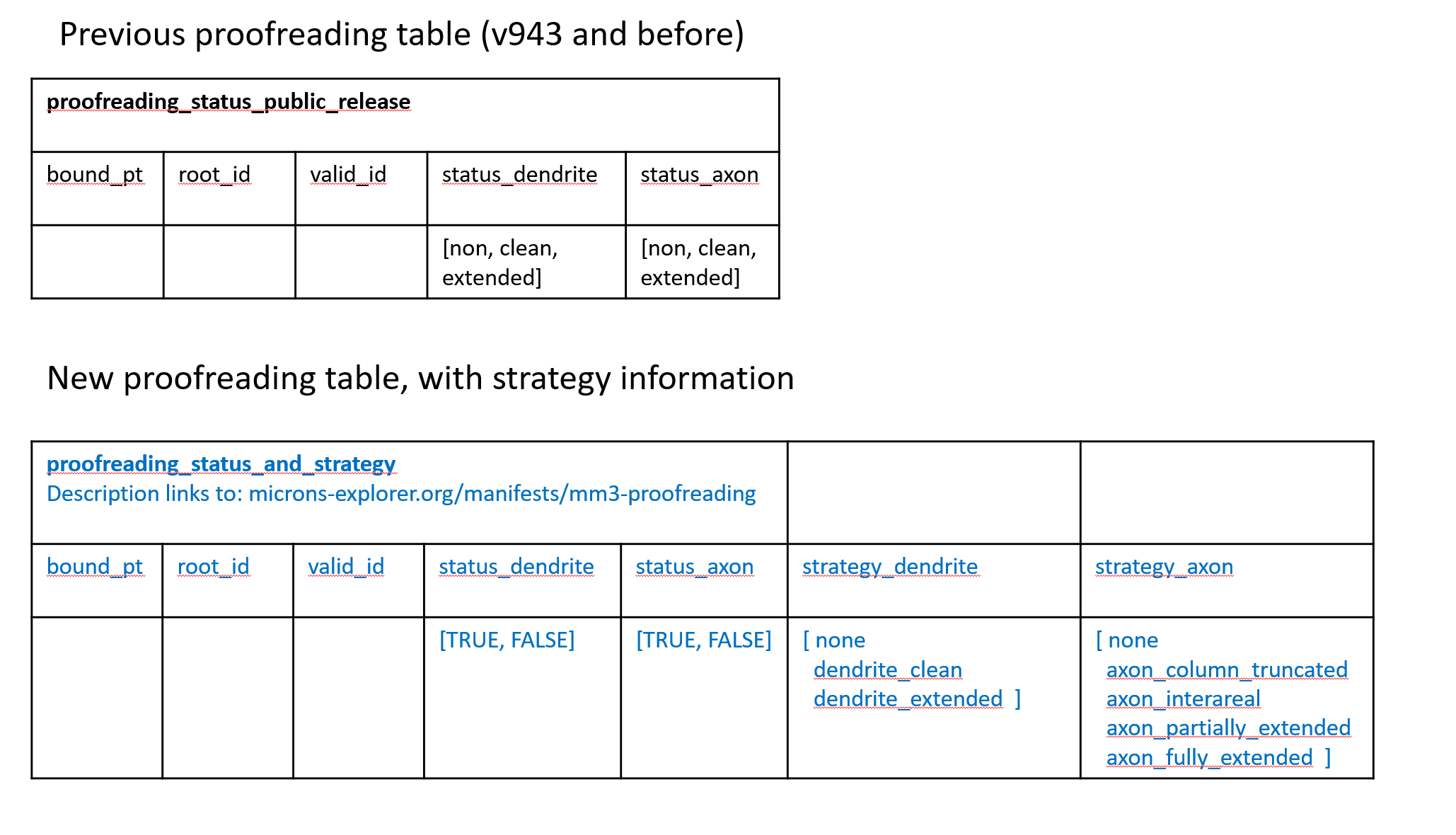Proofreading Strategies
Manual correction of the automatic segmentation—colloquially known as ‘proofreading’—is an import part of data cleaning and curation. Proofreading efforts for the Cubic Millimeter dataset are ongoing, and have been performed by many people across different institutions, both within and outside the MICrONS Consortium. Tracking what cells have been inspected, cleaned, and extended is critical metadata to have for any analysis interested in the morphology and connectivity of neurons and non-neuronal cells.
We track the proofreading status of cells with the “proofreading_status_and_strategy” table, accessible in CAVE and be viewable with the interactive Table Viewer.
If you have cells you would like included in the proofreading status table, click below to fill out a form with the necessary information.
NOTE: we have changed the preferred proofreading status table as of June 2024 (data version 1077), both to simplify the process of finding proofread cells, and provide more detail about the proofreading strategies. The difference with the previous proofreading strategy table is shown below.
Figure 1: outline of the change to the proofreading_status tables. All cells previously included in proofreading_status_public_release have been mapped to proofreading_status_and_strategy with additional strategy information.
The previous proofreading table will remain available, but is deprecated and no longer receives updates. It is recommended to update your analysis to the new table, or else pin the version of your analysis to v943 or before.
Axon and dendrite compartment status are marked separately under 'status_axon' and 'status_dendrite', as proofreading effort was applied differently to the different compartments in some cells.
Each compartment separately may be either:
FALSE: indicates no comprehensive proofreading has been performed, or is not applicable.
TRUE: indicates that false merges have been comprehensively removed, and the compartment is at least ‘clean’. Consult the ‘strategy’ column if completeness of the compartment is relevant to your research.
The strategy applied to each compartment varies as axon’s require more cleaning and extension to be correct than dendrites do, as a function of their small radii and highly convolved paths. In addition, some cells were extended to different degrees of completeness, or with different research goals in mind. This is denoted by 'strategy_axon' and 'strategy_dendrite'.
Additional commentary about each labeling strategy is given below. Each cell is tagged with the most comprehensive strategy used on that cell in cases where one or more has been employed.
Proofreading strategies
-
No cleaning, and no extension. Indicates an entry in proofreading_status that is FALSE for that compartment
-
The dendrite had incorrectly-merged axon and dendritic segments comprehensively removed, meaning the input synapses are accurate.
The dendrite may be incorrectly truncated by segmentation error. Not all dendrite tips have been checked for extension.
No comprehensive attempt was made to re-attach spine heads.
-
The dendrite had incorrectly-merged axon and dendritic segments comprehensively removed, meaning the input synapses are accurate.
Every tip was identified, manually inspected, and extended if possible.
No comprehensive attempt was made to re-attach spine heads.
-
The axon was extended within the V1 cortical column, with a preference for local connections. In some cases the axon was cut at the column boundary and/or the layer boundary, especially the boundary between layers 2/3 and layer 4.
Output synapses represent a sampling of potential partners
-
The axon was extended with a preference for branches that projected to other brain areas. Some axon branches were fully extended, but local connections may be incomplete.
Output synapses represent a sampling of potential partners.
-
The axon was extended outward from the soma, following each branch to its termination.
Output synapses represent a sampling of potential partners.
-
Axon was extended outward from the soma, following each branch to its termination.
After initial extension, every endpoint was identified, manually inspected, and extended again if possible.
Output synapses represent a largely complete sampling of partners.
